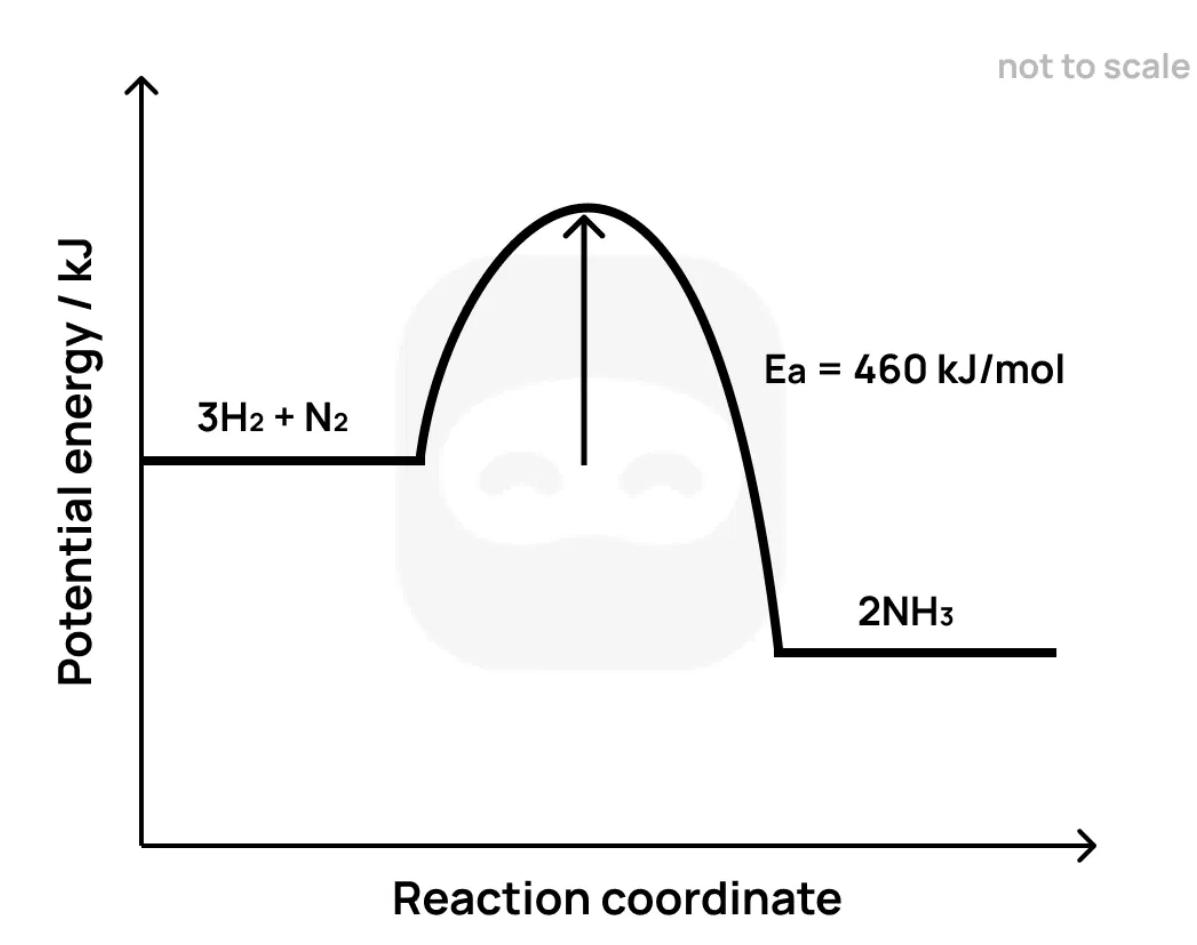

Practice R1.1 Measuring enthalpy change with authentic IB Chemistry exam questions for both SL and HL students. This question bank mirrors Paper 1A, 1B, 2 structure, covering key topics like atomic structure, chemical reactions, and organic chemistry. Get instant solutions, detailed explanations, and build exam confidence with questions in the style of IB examiners.
Ammonia is formed by the Haber process:
The diagram below shows the energy profile of this reaction.

State what is meant by the term activation energy.
Identify whether the reaction is exothermic or endothermic and justify your answer using the diagram.
Suggest one reason why a high temperature is required for this reaction to proceed at a practical rate.
Explain how the use of a catalyst would affect the energy profile diagram.
The Haber process is a reversible reaction. State and explain one condition used in industry to increase the yield of ammonia.
A student investigates the enthalpy change when potassium chloride () dissolves in water. They dissolve of in of water and observe the temperature drop from to . The specific heat capacity of water is and the molar mass of is .
Calculate the heat absorbed by the water using .
Calculate the number of moles of dissolved.
Determine the enthalpy change of solution for in . Include the sign.
State the physical meaning of the sign of your answer to Part 3.
Discuss why the dissolution of an ionic solid like can be spontaneous even when it is endothermic.
Photosynthesis can be represented by the following equation:
The energy profile diagram for photosynthesis is shown below.
State the meaning of the term endothermic reaction.
State and explain whether photosynthesis is an exothermic or endothermic reaction based on the diagram.
Explain the role of light energy in this reaction.
State two ways in which the energy profile diagram would change if a catalyst (e.g., an enzyme) were used.
Suggest why photosynthesis would not occur in the dark, even if all reactants are present.
A student is preparing a warm salt solution in a laboratory. They place a beaker of distilled water over a Bunsen burner and heat it before adding table salt ().
State the difference between heat and temperature.
Identify whether heating water is a physical or chemical change.
Explain why the temperature of the water increases as it is heated.
State the physical state and movement of water particles before and after heating.
The student accidentally leaves the beaker boiling. Suggest one safety precaution to prevent accidents from overheating.
In a school lab, a student heats of water using a spirit burner. After a few minutes, the temperature of the water rises by .
State the specific heat capacity of water.
Calculate the heat absorbed by the water using the expression .
Suggest why the calculated value of might be lower than the actual energy released by the burner.
Identify one way the student could improve the accuracy of this measurement.
The diagram below represents the potential energy changes during the combustion of methane:
The activation energy of the reaction is .

State the meaning of the term activation energy.
Identify whether this reaction is exothermic or endothermic. Justify your answer using the diagram.
Explain how a catalyst would affect the energy profile diagram.
Predict how increasing the temperature would affect the rate of this reaction.
The combustion of methane releases energy. State one practical use of this energy release in everyday life.
During a school demonstration, a teacher dissolves a white crystalline substance into water. Students observe that the temperature of the beaker drops noticeably.
State whether this reaction is endothermic or exothermic.
Suggest one reaction that could cause this temperature drop.
Describe the direction of heat flow in this process.
State how the kinetic energy of water molecules changes during the reaction.
The teacher repeats the experiment with double the amount of substance. Predict how the temperature change would be affected.
Ammonia is produced industrially by the Haber process:
The diagram below shows the energy profile for this reaction.

Given that the enthalpy change ( ) for the reaction is -92 kJ mol-1, calculate the activation energy for the reverse reaction.
Explain, using the collision theory, why increasing the temperature increases the rate of ammonia formation.
Sketch how the energy profile would differ if a catalyst were added to the system.
The rate equation for the Haber process under certain conditions is:
Determine the overall order of the reaction and explain how this would affect a rate vs. [H2] graph.
State one industrial compromise for pressure and temperature that balances rate and yield in the Haber process, and explain your reasoning.
A student burns ethanol in a simple calorimeter and observes a sharp temperature increase in the surrounding water.
State whether the combustion of ethanol is exothermic or endothermic.
Sketch an energy profile diagram for this reaction.
Label the activation energy, reactants, and products on your diagram.
Explain, using bond enthalpies, why combustion reactions are typically exothermic.
The student suggests using propane instead of ethanol. Predict how the temperature change in the water might differ and justify your answer.
A student investigates the energy content of ethanol by burning of ethanol under a beaker of water. The combustion heats of water, raising its temperature by . Molar mass of ethanol = Specific heat capacity of water =
Calculate the energy released using the expression .
Calculate the number of moles of ethanol burned.
Determine the molar enthalpy change for combustion of ethanol, in , including sign.
State why the value obtained is lower than the literature value of .
Suggest one way the experiment could be improved to obtain a value closer to the literature value.